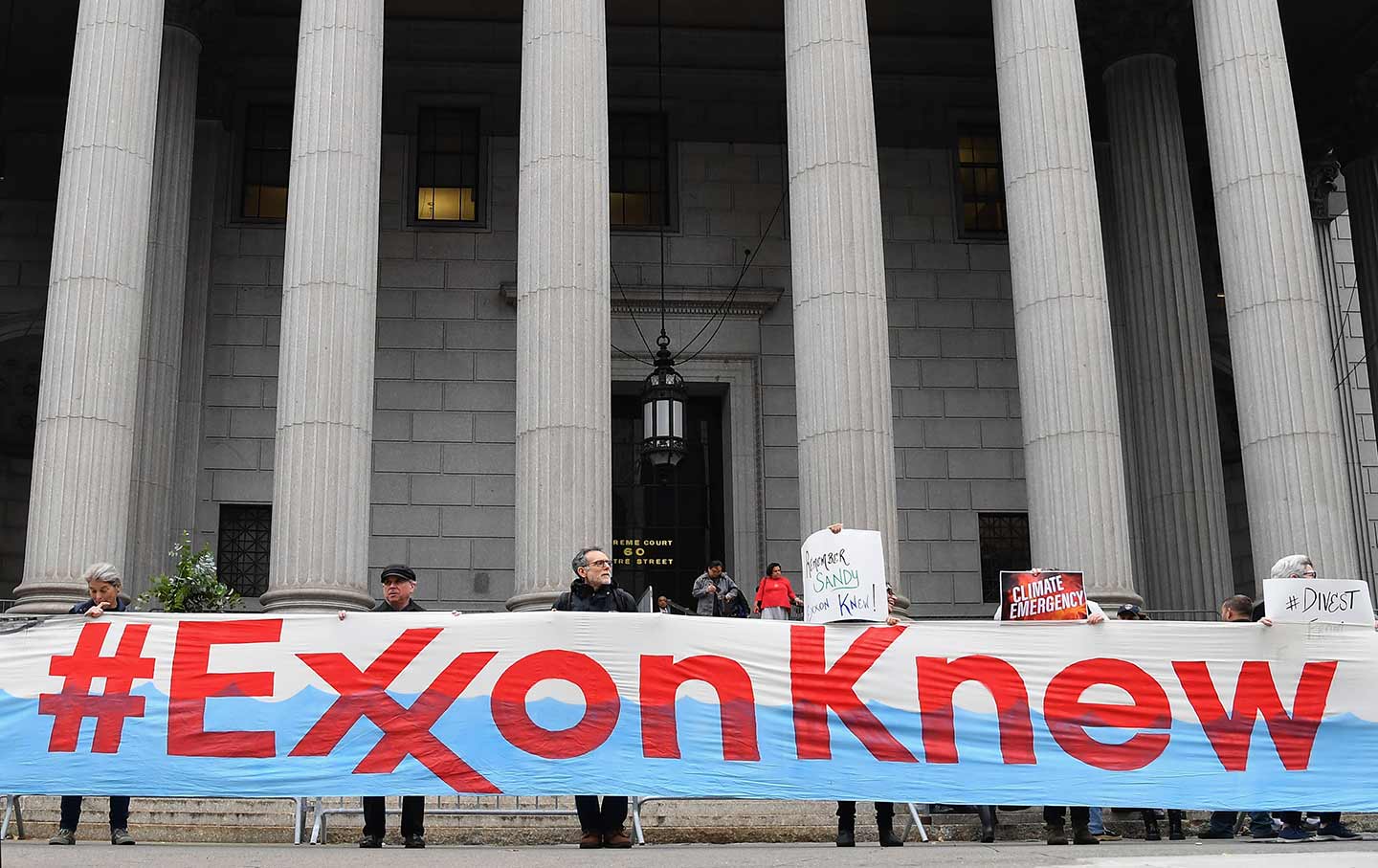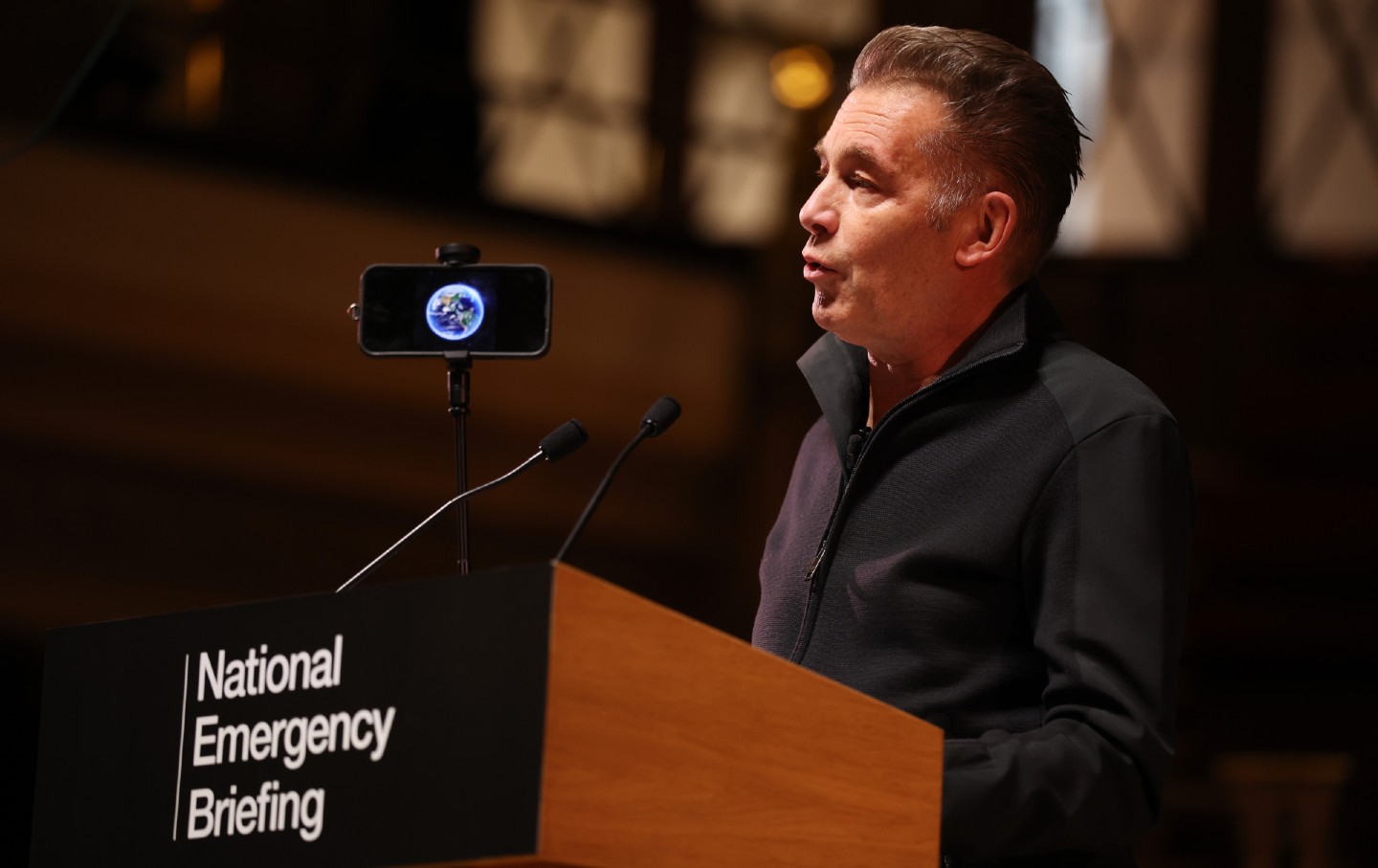How Oil Companies Manipulate Journalists
A tranche of 4,700 subpoenaed e-mails reveals the ways in which fossil-fuel corporations try to influence the media—and why they all too often succeed.

Climate activists protest on the first day of the Exxon Mobil trial outside the New York State Supreme Court building on October 22, 2019.
(Angela Weiss / AFP via Getty Images)“Kill the story.”
That’s what Alan Jeffers, a media relations manager at ExxonMobil, told the Houston bureau chief of Reuters in October 2016, about a year after InsideClimate News, the Los Angeles Times, and Columbia Journalism School began publishing reports revealing ExxonMobil’s decades-long campaign to deny climate science.
The Reuters bureau chief had forwarded Jeffers a press release from the Center for Media and Democracy about a filing the group made to the IRS alleging that the American Legislative Exchange Council was abusing its nonprofit status by lobbying for Exxon’s climate-denial policies. (The Reuters journalist did not respond to requests for comment.)
“It’s inaccurate and misleading to your readers and part of the activists’ stated objective to delegitimize a company that obeys the law, provides a product we couldn’t live without and generates significant jobs and economic activity for the country and the world,” Jeffers wrote.
“Hey man, I just said somebody asked me to file on it,” the Reuters bureau chief responded. “I didn’t say a story was going to run.”
Jeffers apologized (“clearly need more coffee… sorry again for the rant”) and forwarded the exchange to Cynthia White, Exxon’s then–government affairs manager.
“This is so great,” White wrote back. She joked that all Exxon employees should change their e-mail signatures to include Jeffers’s claims about activists trying to delegitimize the oil giant.
This exchange is part of a trove of 4,700 internal oil-and-gas-industry documents released by House Oversight Committee Democrats in late April in advance of its bicameral hearing with the Senate Budget Committee, “Denial, Disinformation, and Doublespeak: Big Oil’s Evolving Efforts to Avoid Accountability for Climate Change.” The documents are the second cache of materials obtained from a House Oversight investigation into the industry’s campaign to deceive the public on how its products drive the climate crisis.
As a reporter, it’s satisfying to see how the companies we cover talk about journalists in private. The documents range from company materials discussing marketing strategy to moments of internal strife as execs clash with colleagues and reporters. I have to confess to loving some of the mess, from higher-ups at Shell expressing frustrations about the company’s president to Exxon CEO Darren Woods taking issue with the use of spacing in a document.
Stepping back, these documents also reveal what coverage these fossil-fuel companies are pleased to receive, the kinds of reporters they try to curry favor with, and the ways they try to manipulate journalists. They also show how Big Oil could actually get a more pliant media it so desperately wants.
In September 2015, InsideClimate News and the Los Angeles Times, in collaboration with Columbia University, published their first reports on how ExxonMobil conducted its own climate-science research and yet for decades continued to fund climate denial and lobby for inaction on climate change. In an internal e-mail sent in early December of that year, Pamela Kevelson, then a corporate communications writer at Exxon, discussed how the company could continue to push back on the stories.
“We don’t actually dispute much of what these stories report…but it’s how you interpret the facts,” Kevelson wrote (emphasis in the original).
The question is why did THEY interpret the facts so negatively?
It helps to really hammer home the difference between these advocacy-funded journalists and traditional journalists. If I am an energy reporter at the New York Times…am I looking at these stories and thinking, “Wow. That’s a great scoop. Wish I got that.” Or am I thinking, “The story seems pretty thin, and it sucks that these guys are getting attention for that article.” My guess is it’s the latter.
(InsideClimate News was nominated for a Pulitzer Prize for its reporting on Exxon.)
For nearly a century, the oil and gas industry has been obsessed with controlling its image in the media, especially in outlets that cater to elite audiences. Beginning in 1970, Mobil Oil Corporation ran advertisements promoting its product and views in the New York Times opinion section that were designed to look like columns—material that later became known as “advertorials”—and also sponsored PBS’s Masterpiece programs. The partnership, the company’s vice president for public affairs, Herb Schmertz, later said, helped establish Mobil, which merged with Exxon in the 1990s, in the public’s eye as “the thinking man’s oil company.”
But in the middle of the last decade, that carefully constructed image began to crumble. Kevelson was both correct and off the mark in her predictions of how journalistic powerhouses would react to the story that Exxon lied to the public. Though outlets like The Washington Post, The New York Times, and the television networks were slow to cover the Exxon revelations, a number of outlets began to examine what Big Oil knew about how its product was driving climate change and when the industry knew it.
A slew of legal action followed. First, investigations from attorneys general in New York, Massachusetts, and the US Virgin Islands, and then, beginning in 2017, a cascade of lawsuits from cities, states, tribes, and municipalities. There were nearly 30 ongoing cases as of the start of this year, according to the Center for Climate Integrity. Meanwhile, the 2015 Paris Agreement, for the first time, got the world to promise to bring down emissions. Many major oil companies, sensing a PR opportunity, put out statements in support of the accords.
The documents released by the Senate Budget Committee, which range from 2015 to early 2022, portray an industry searching for a foothold in a changing world. While publicly declaring support for the Paris Agreement and touting “green” initiatives and projects, executives strategized how to spin narratives with journalists that would help protect their bottom lines and insulate them from further climate criticism.
One BP strategy document set a goal for the company to “get more stories placed,” including ones around “our climate position,” and to “focus on engaging non-traditional, specialty publications and outlets, while getting stories placed in national news outlets, ideally on the front page.”
Controlling the narrative—particularly in business publications—took top priority for executives. In early 2021, BP produced a five-page memo for an unnamed executive to prepare for an “on-the-record, exclusive to [The Wall Street Journal] about bp’s journey to net zero and how we are reducing methane at our Permian Basin assets”—a favorite topic of oil majors eager to demonstrate good behavior in order to head off government methane regulations. That same year, a lengthy internal e-mail chain prepared BP executives for an upcoming Bloomberg Businessweek story on gas flaring. “We expect this to be neutral/fair coverage but could be negative,” BP’s head of corporate communications warned.
Popular
“swipe left below to view more authors”Swipe →Collecting information about reporters has also been part of oil companies’ media strategies. The five-page BP memo defines the Journal as a “highly regarded global outlet,” and says the reporter “has always been a fair and balanced reporter when working with bp.” In 2018, Shell executives compared similar notes on a Seattle Times reporter writing on a carbon price who had asked a question of the company. The reporter “is not a media activist,” one media manager wrote, but “he’s shown a personal enthusiasm for some form of a carbon tax in Washington (and California).” The e-mail notes Shell’s efforts to have an off-the-record call with the reporter “in an attempt to reason with him.”
One particularly clarifying exchange came in June 2019, as BP executives wrestled with how to respond to a question from The Guardian—a left-of-center publication in the United Kingdom, BP’s home country—regarding calls for the European Union to more ambitiously cut its emissions. (Later that year, the EU introduced a proposal to become “carbon-neutral” by 2050.).
“I think how we answer this question, to the Guardian in particular, is important, and not straightforward,” one executive wrote. “Whereas our comments on ambitious targets in the past might have been that they are costly, damaging and difficult to achieve, comments that might have been perceived as opposition, I don’t think we can make such comments any longer on targets that are intended to deliver the Paris goals.”
Sometimes, oil companies misjudged the types of reporters they were dealing with—with disastrous results. In 2019, Shell invited journalist Malcom Harris, author of a book on millennials and a Nation contributor, to speak at an internal company workshop. Harris did what any good journalist would do: He checked to see if there was an NDA, then attended the meeting and took notes. The resulting report in New York magazine, “Shell Has a Plan to Profit From Climate Change,” is a PR person’s nightmare: an on-the-ground account of how Shell is “hoping to leverage their incumbency, and fossil-fuel wealth, to lay claim to the world’s clean-energy future as well.”
In internal e-mails after Harris’s article was released, Shell PR executives were appropriately apologetic. “I am really sorry that there was nothing we could do in this instance,” a senior spokesperson wrote.
Other executives, however, were more blasé. “I don’t know this publication,” one wrote. “Does anyone read it? I hope not…”
“New York mag is a local rag,” another replied. “It’s often confused with the prestigious New Yorker magazine—but there is really no comparison.”
This year has already been one of the worst for working journalists: More than 500 jobs have been slashed in 2024 alone. Award-winning outlets that made their names fearlessly challenging big businesses, like Vice and BuzzFeed News, no longer exist, while others, like The Intercept and the Center for Public Integrity, are teetering on the edge. Even more worrying, more than half of US counties are no longer covered by a local news outlet.
The very nature of how media is supported and paid for is also changing. Many outlets that have managed to survive—and even thrive—in this media hellscape have a blatantly corporate bent, relying on pricey company subscriptions: Start-ups like Punchbowl, Axios, The Information, and Politico offer premium access for hundreds or thousands of dollars a year. Media reporter Max Tani wrote for Semafor last month about how outlets are increasingly shying away from tough investigative stories, as a worsening legal climate and a greater emphasis on the bottom line make editors less eager to take on stories that could have costly legal fees down the line.
Big Oil, meanwhile, is supporting the business model of the remaining major US outlets. A recent investigation by Drilled and The Nation found that Bloomberg, Reuters, Politico, The Washington Post, and The New York Times all count major fossil fuel producers as clients for their in-house production studios, events businesses, and other branded content. The New York Times alone took in more than $20 million from fossil fuel companies over a three-year period. (Climate reporters that Drilled and The Nation spoke to for the piece on paid content panned the practice, saying running ads from oil and gas companies undermined the work they were doing to report accurately on climate.)
I can easily see how the crumbling journalism ecosystem could give Big Oil the media environment of its dreams: one that is increasingly favorable to executives who pay for subscriptions, staffed with journalists under pressure from owners to stick to corporate-friendly coverage rather than investigative work that could undercut their funding.
At the very least, these documents released by the Senate Budget Committee provide lessons for journalists dealing with oil companies—to know that they’re keeping notes on you, your outlet, your potential opinions on climate action, and whether or not you can come around to their narrative. Journalists now know that Big Oil has a playbook, and it’s our responsibility to study it and factor that into our coverage.
I hope reporters on all beats get savvier about how they cover business, especially oil and gas. But it’s tough just to keep any kind of job in journalism these days, especially when you’re sticking your neck out there. The Reuters bureau chief, for what it’s worth, after 12 years with Reuters, now works in corporate communications for Aramco Americas, a subsidiary of Saudi Aramco, the world’s largest oil-and-gas company.
Disobey authoritarians, support The Nation
Over the past year you’ve read Nation writers like Elie Mystal, Kaveh Akbar, John Nichols, Joan Walsh, Bryce Covert, Dave Zirin, Jeet Heer, Michael T. Klare, Katha Pollitt, Amy Littlefield, Gregg Gonsalves, and Sasha Abramsky take on the Trump family’s corruption, set the record straight about Robert F. Kennedy Jr.’s catastrophic Make America Healthy Again movement, survey the fallout and human cost of the DOGE wrecking ball, anticipate the Supreme Court’s dangerous antidemocratic rulings, and amplify successful tactics of resistance on the streets and in Congress.
We publish these stories because when members of our communities are being abducted, household debt is climbing, and AI data centers are causing water and electricity shortages, we have a duty as journalists to do all we can to inform the public.
In 2026, our aim is to do more than ever before—but we need your support to make that happen.
Through December 31, a generous donor will match all donations up to $75,000. That means that your contribution will be doubled, dollar for dollar. If we hit the full match, we’ll be starting 2026 with $150,000 to invest in the stories that impact real people’s lives—the kinds of stories that billionaire-owned, corporate-backed outlets aren’t covering.
With your support, our team will publish major stories that the president and his allies won’t want you to read. We’ll cover the emerging military-tech industrial complex and matters of war, peace, and surveillance, as well as the affordability crisis, hunger, housing, healthcare, the environment, attacks on reproductive rights, and much more. At the same time, we’ll imagine alternatives to Trumpian rule and uplift efforts to create a better world, here and now.
While your gift has twice the impact, I’m asking you to support The Nation with a donation today. You’ll empower the journalists, editors, and fact-checkers best equipped to hold this authoritarian administration to account.
I hope you won’t miss this moment—donate to The Nation today.
Onward,
Katrina vanden Heuvel
Editor and publisher, The Nation
More from The Nation

What Your Cheap Clothes Cost the Planet What Your Cheap Clothes Cost the Planet
A global supply chain built for speed is leaving behind waste, toxins, and a trail of environmental wreckage.

The UK’s Climate National Emergency Briefing Should Be a Wake-Up Call to Everyone The UK’s Climate National Emergency Briefing Should Be a Wake-Up Call to Everyone
The briefing was a rare coordinated effort to make sure the media reflects the science: Humanity’s planetary house is on fire, but we have the tools to put that fire out.

AI Will Only Intensify Climate Change. The Tech Moguls Don’t Care. AI Will Only Intensify Climate Change. The Tech Moguls Don’t Care.
The AI phenomenon may functionally print money for tech billionaires, at least for the time being, but it comes with a gargantuan environmental cost.

Backsliding in Belém Backsliding in Belém
Petrostates at COP30 quash fossil fuel and deforestation phaseouts.

Wake Up and Smell the Oil. Your Nation’s Military Is Hiding Its Pollution From You. Wake Up and Smell the Oil. Your Nation’s Military Is Hiding Its Pollution From You.
A fact all but ignored at COP30.

Trump Promised to Bring Back Coal. This Town Listened. Trump Promised to Bring Back Coal. This Town Listened.
Through executive orders, Congress, and a loyalist cabinet, the Trump administration has delivered big for enclaves of coal country like Colstrip, Montana. But how long can it las...


